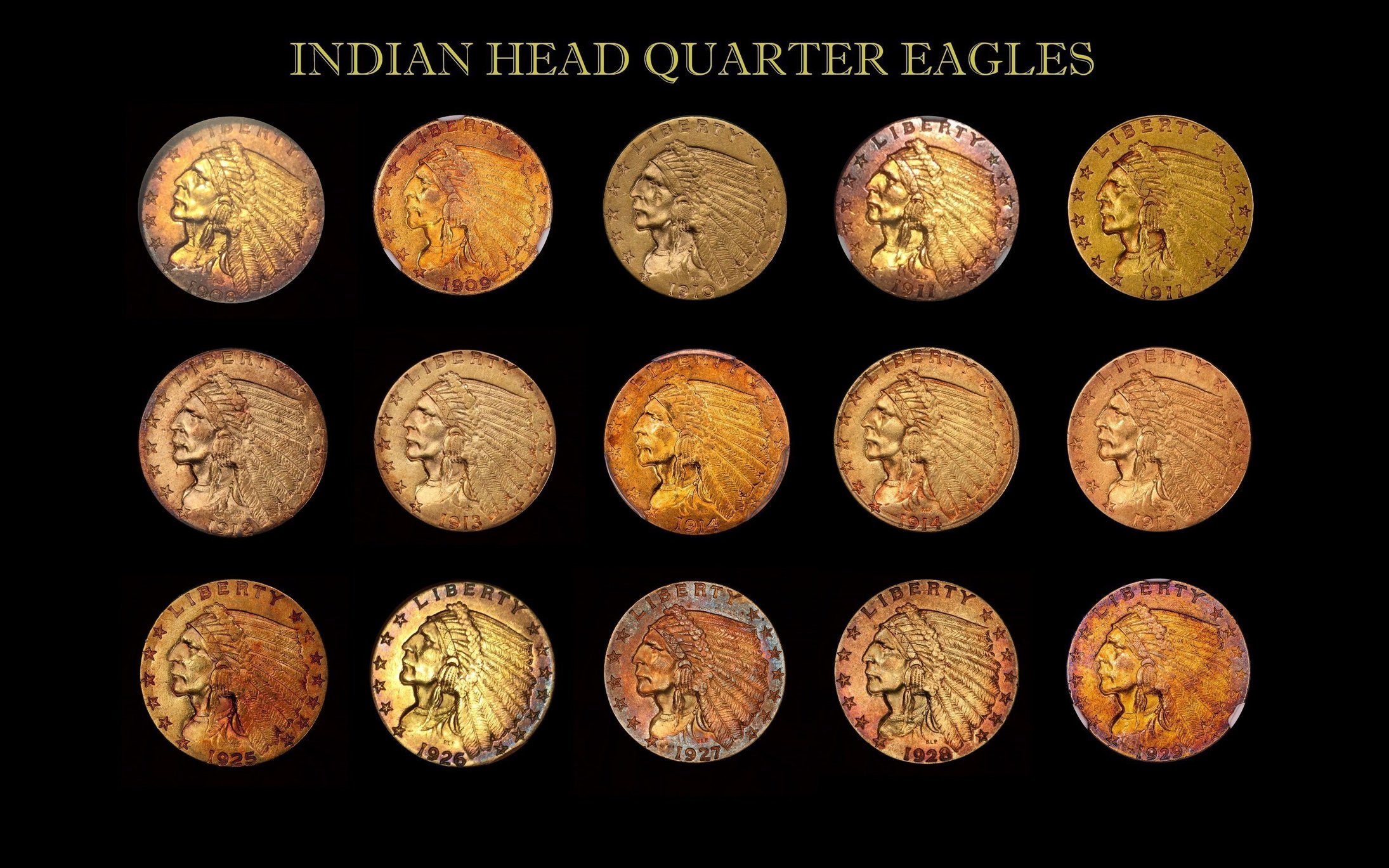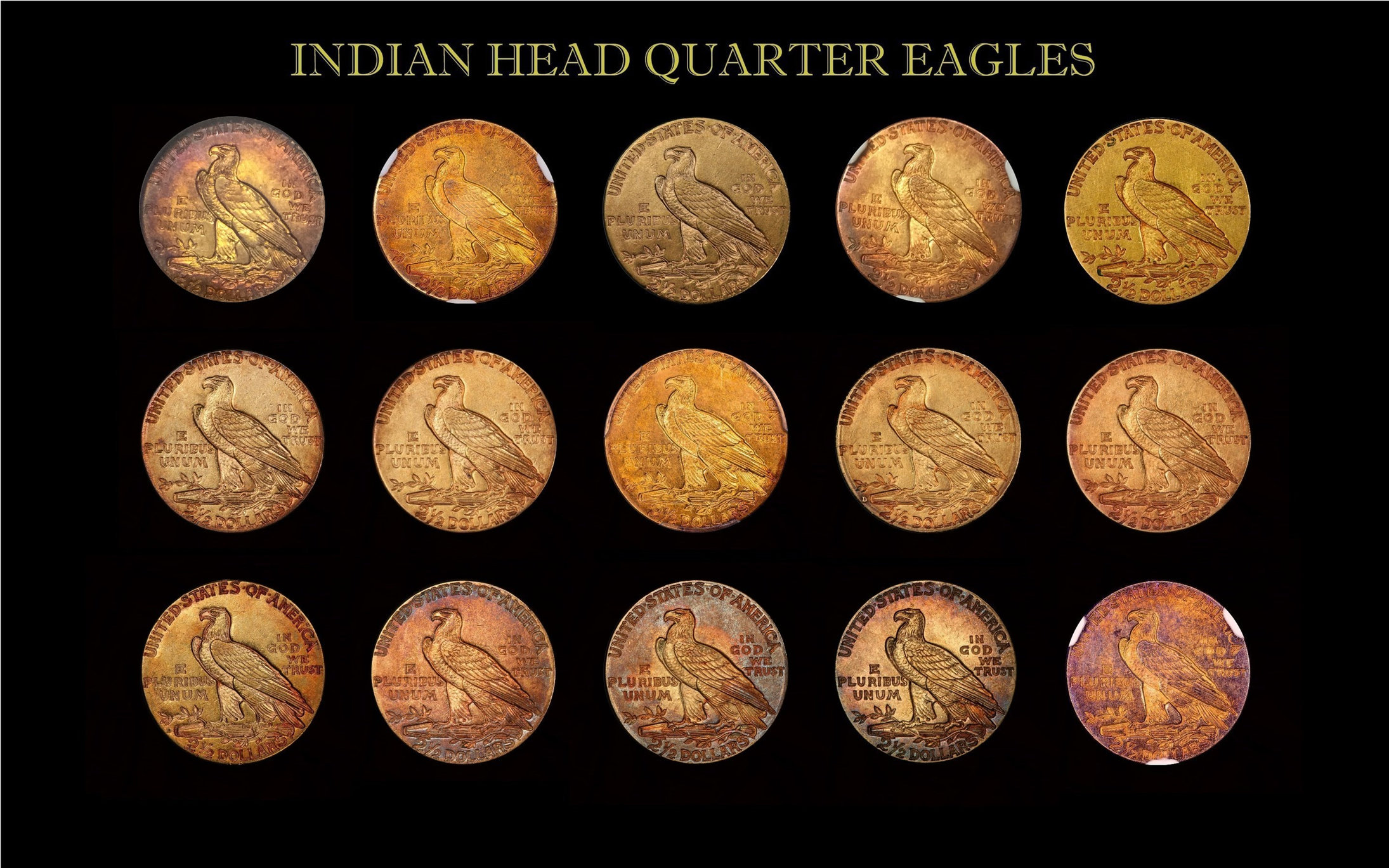Why does gold tone?
 CommemKing
Posts: 2,202 ✭✭✭✭✭
CommemKing
Posts: 2,202 ✭✭✭✭✭
I have seen pure gold toners and more 90% gold toners now and then. Usually always purplish in color. I know gold is not an active metal so that's not it. Is it the copper added? if so, that explains 90% gold coins toning, but how do explain pure .999 fine gold toning?
There is a thread on the board now showing a $10 Indian with deep purple tone. How does that happen?
Sorry, I'm full of questions.
0
Comments
I don't understand it, but I'm addicted to it


Get a copy of Henley's book. I have a forty year old copy. Looks like they have revised it and dropped "Trade Secrets" from the title.
It’s the 10% of the coin that is copper that tones.
The only time I've trouble with gold toning was when I had my collection stored in a safe deposit box at a small bank branch in the suburbs. The vault was on an outside wall, and it was wintertime in northern New Jersey. The bank turned off the heat at night with allowed the temperatures to go up and down constantly. I had a gold piece grow copper stains, which ruined it at the time.
That taught me a lesson. I only deal with bank vaults with inside walls at banks that tend to keep their interior temperatures steady. I found the same thing to be true with closets in my home where I stored modern Proof sets. Up and down temperatures can mess up coins.
I still can't understand why some Buffalo gold coins which are supposed to be .999 gold grow spots. One would think that it would be easy to rinse them off without damaging the coin because gold is largely inert.
Perhaps it is the .001?
Multiple careful studies have show that "copper spots" are superficial contamination during manufacture or later removal from original packaging. Depending on the contaminate, they can be removed or are permanent. If the center is black or purple-black, the particulate has bonded with the metal surface either mechanically or chemically (depending on alloy).
PS: You can get purple tones by exposing gold to ammonia (or urine), ammonium nitrate, or contaminated sodium hypochlorite.
So if you like gold toners you can just.....?
Right up there with nose grease....
I don't mind light copper spots and find some mixtures of gold a coppery toning to be very attractive. I don't care for these pieces with deep copper toning or the purple spots. Gold should look like gold.
The modern gold eagle coins also has silver in addition to the copper, that tones too.
So do I just pee on my gold then set it out in the sun, in a zip lock baggie or what? TIA
The whole worlds off its rocker, buy Gold™.
BOOMIN!™
Wooooha! Did someone just say it's officially "TACO™" Tuesday????
So why is it that copper is added to gold anyway? Even .001 ....
To make it hard enough to survive in circulation. Gold is the most ductile metal there is. It can be pounded into sheets that are thin enough to be translucent. Pure gold would worthless for "real," useful coinage.
I thought the coin doctors were masters of using highly toxic chemicals like cyanide and mercury to tone gold.
I've yet to see anyone show a definite proof that they can tone gold. Many people have told me how easy it is, but no one has shown proof. With the prices I've paid for a few of my coins, you would think someone would give it a try. Show me a coin that is untoned, show me the process of you toning it and getting it graded, then I will buy it from you if it straight grades.
Cant believe there are no real solid explanations yet. I'm just not believing the little amount of copper in these coins can make pure gold turn purple.
When copper (or other metals) are alloyed with gold, the alloy will take on it's own properties including reactivity with outside elements. A simple example would be CuNi cents vs. bronze and copper cents. CuNi is very resistant to tarnish wehreas bronze and copper are much more reactive. There is no logic that a 5% copper content in a gold coin could mean that the coin will be only 5% toned.
This is true of all alloys. I hopes this helps.
OINK
Actually, .999 gold is considered pure 24K gold for all practical purposes and that .001 is contamination. The cost of refining it further is not worth the expense. With current technology, pure gold has even more 9's---.9999 or even .99999 fineness. As far as circulating gold coins (usually .900 or 22K) copper is added to harden the alloy to help it survive to rigors of circulation.
Worry is the interest you pay on a debt you may not owe.
"Paper money eventually returns to its intrinsic value---zero."----Voltaire
"Everything you say should be true, but not everything true should be said."----Voltaire
If we can make a 0.9999 gold coin, what's holding us back from making a 1.0000 gold coin?
At least three of the four major grading services have added coin conservation to their business. Few know this but the idea for NCS was formed when I removed one or two (I forget exactly) copper spots from a $10 Indian and the eye appeal + its grade increased. I did another coin that same day. A month or two later I was out of the authentication/grading room and changing those colorful coins you love
love  back to the way they were made. Please don't hate me.
back to the way they were made. Please don't hate me. 
Heisenberg's uncertainty principle?
Gold that is 1.000 fine is perfectly pure which doesn't exist in nature. All we can do is add more 9's such as .9999999999999999999 fine gold but that would require the gold to be refined in a sterile laboratory environment which is impractical and extremely expensive and also unnecessary.
Worry is the interest you pay on a debt you may not owe.
"Paper money eventually returns to its intrinsic value---zero."----Voltaire
"Everything you say should be true, but not everything true should be said."----Voltaire
It could be necessary to stop the toning

I thought coin collectors liked toning.
Worry is the interest you pay on a debt you may not owe.
"Paper money eventually returns to its intrinsic value---zero."----Voltaire
"Everything you say should be true, but not everything true should be said."----Voltaire
Read The Black Swan
Latin American Collection
No process can capture every atom that is not gold in a given sample.
I am glad that you got into the business of removing unsightly spots on gold. I once had an Indian quarter eagle that an ugly blueish – purple spot in the depressed area of the Indian's neck. The coin was Choice Unc. except for that problem, which made it unsaleable.
NCS removed the spot and the coin looked very nice. It was not the dreaded “white gold” which many collectors don’t like. NGC graded the coin MS-64 as I recall. My only concern was that the spot might return in time.
What is the title of the book or the full name of the author, please and thank you.
The coin was Choice Unc. except for that problem, which made it unsaleable.
Must not have tried selling it to me!
@ShadyDave asked: "What is the title of the book or the full name of the author, please and thank you."
Do you promise not to "doctor" coins with chemicals?
@BillJones said: "NCS removed the spot and the coin looked very nice. It was not the dreaded “white gold” which many collectors don’t like. NGC graded the coin MS-64 as I recall. My only concern was that the spot might return in time."
I've never had the luxury of owning any of the gold we conserved. So do the spots removed from gold come back? My guess is they can depending on the type of spot and the storage conditions. When the "whatever" that caused the spot is physically removed, I say no. If it is from an "unseen" impurity in the alloy near the surface, perhaps eventually.
I have a Buffalo nickel that is a fully struck gem. About every three years I need to remove a recurring spot in the field where nothing appears under the microscope.
So many coins were cracked out of their old holders and dipped to get more luster out of them; I did that a few times early on, some coins went from unc. to AU58 and a few went up. Not worth it, but that is the tragedy of the numbers game.
Just got the $10 Indian in... I'm gonna have to make a video for all yall haters out there! I love it!
Another good publication is the 'COIN PRESERVATION HANDBOOK' by Charles Frank..... Excellent information on coin metals and effects of chemicals etc.. Cheers, RickO
Good thread.
My YouTube Channel
My observation is that $10 Indian proofs will show a variation in color but not toning as exhibited on jwitten's gold coins. Yet they are all 90% gold and 10% copper. My theory is that the toning comes from people handling them, but not circulating them or using them for pocket change. The body oils would not effect gold like it would silver and would provide some cause for the toning. If the coin were .999 gold I would think that there would be no toning at all. The gold copper alloy does seem to be succeptable to toning.
OINK
It is simply NOT true that gold does NOT tone. It won't oxidize in oxygen, but there are numerous chemical compounds that will oxidize it.
All comments reflect the opinion of the author, even when irrefutably accurate.
Alloys of all metals have different characteristics than their base metals. Old gold coinage was composed of 90% gold and 10% copper. The reactivity of this alloy does not have the same characteristics of the base metals. Gold will react with certain substances, but for numismatic purposes it is not common. From my review of $10 Indians, it would appear to me that about 10% possess interesting toning. Certainly all came out of the mint looking identical. I can only conclude that those that have toning were subject to an environmental condition that "caused" it. And I think it unlikely the toning is AT as most of us would define it.
Toned gold, like toned copper, make for very special coins.
OINK
A very interesting thread!
Later, Paul.
I like my gold gold and my silver can just sit there and do what it wants.
``https://ebay.us/m/KxolR5
Wow, very nice coins. Thanks for posting it
I just noticed a few days back that my wonderful GOLD SLQ had developed some ugly copper spots.
Offed it locally. Lost a few bucks but I should never have ordered it.
Phoo.